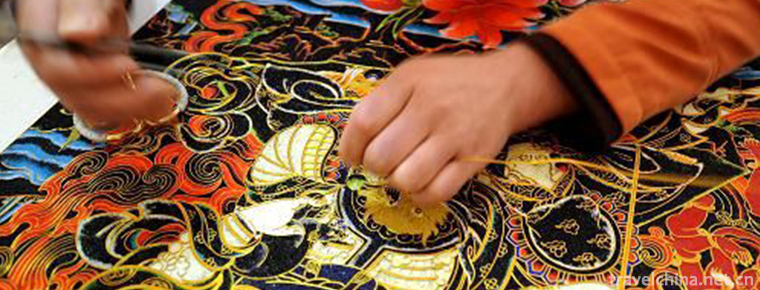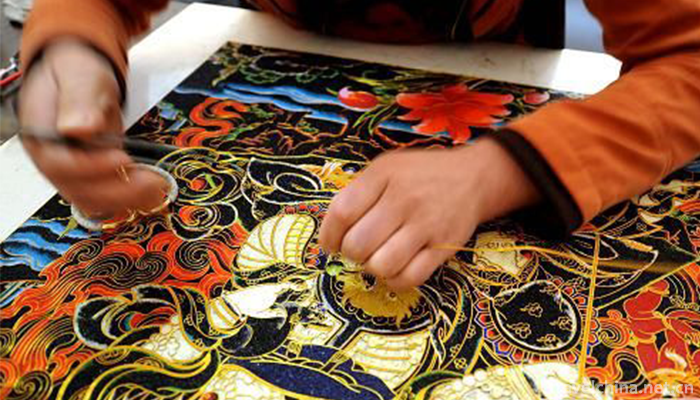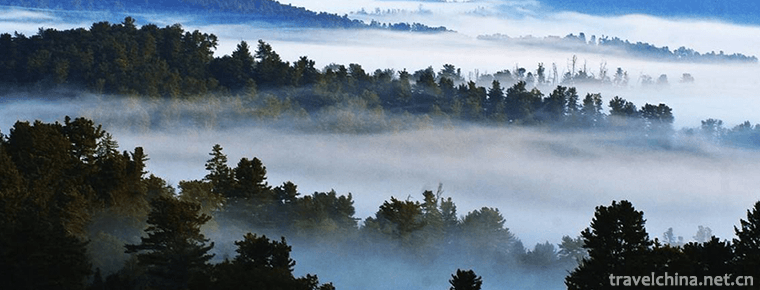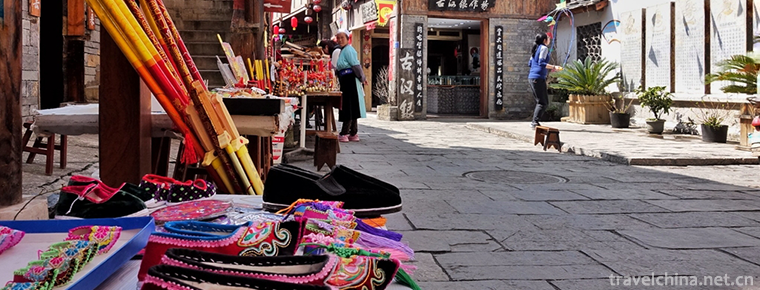2018-12-19

- By ChinaWiki.net
- Chinese Edition
- 2019-04-05
Weaving Techniques of Tibetan Bangdan and Kapa
The woolen apron commonly used by Tibetan people is called "Bangdian" in Tibetan, which has the functions of decoration and cold resistance. Jiedexiu Town, Gongga County, Shannan District, Tibet is the main producer of Tibetan aprons, so it is known as "the town of Bangdian".
In 2006, Tibetan Bangdian and Kamat weaving techniques were approved by the State Council and listed in the first batch of national intangible cultural heritage list.
Origin of skills
Tibetan woolen technology has a long history, and its products are most famous for aprons and carpets. Jiedexiu Town, Gongga County, Shannan District, Tibet is the main producer of Tibetan aprons, so it has the reputation of "the town of Bangdian". Jiangzi County in Xigaze District is a famous carpet town in Tibet. Jiangzi carpet, Turkish carpet and Persian carpet are also known as the three famous carpets in the world. Tibetan carpet mainly refers to "satin" (carpet, carpet on the ground) and "card mattress" (mattress, mattress on the surface of the mattress. According to different specifications, carpets with an area larger than 18 square feet are called carpets and small ones are called "card pads". Jiangzi Kamat is the most famous, known as the "home of Kamat".
Technical representative
Pang Dian
Bangdian is a special symbol of Tibetan women's Tibetan clothing. It is a colorful, thin horizontal line of bathroom (raw material of Tibetan gown). Later, it became a decoration that Tibetan women like to tie around their waists, and gradually became a synonym for Tibetan apron. Its raw material is the same as the bathroom, but it is thinner, more delicate and smaller than the bathroom. Tibetans use bangdian scriptures to make shoulders, aprons and bags for women, or to set them on the edge of Tibetan robes. Modern people also use them to decorate the living room walls.
Technological process
Bongdian is wool fabric, which is knitted precisely, beautiful and generous, and colorful. It is produced by spinning wool into yarn, dyeing and brushing, weaving into strips and stitching into aprons. The apron has unique weaving method and precise weaving. Women in farming and pastoral areas like to match with strong contrasting stripes, while women in cities and towns choose to form elegant and gentle tones with fine related colors. Bangdian has two kinds of broad lines and fine lines. Wide lines are made up of strong contrast tones and have a rough and lively style, which is loved by women in farming and pastoral areas. Fine lines are composed of delicate and gentle tones, which are chosen by urban women. The production process of Bangdian is not simple: the original raw material is fine wool, after combing and twisting yarn (fine twisting for warp, rough twisting for weft), loom (warp shuttle beating, weaving, weaving, coloring, repeated sizing, rubbing, drying and other processes, a finished Bangdian can be completed. Among them, dyeing is a rock and vegetable dyestuff prepared by Tibetan special folk craft. Wool thread can dye more than 20 kinds of brilliant colors, and will never fade. Twisting is time-consuming and laborious work, men can not do it, so it has been a female twist, male loom since ancient times.
main features
Aprons are unique in weaving, bright in color, precise in weaving and elegant in appearance. Aprons are usually produced by hand spinning, dyeing, brushing, weaving into strips, and then sewing into aprons. There are many kinds of aprons. The best Tibetan language is "skewed horse", which is woven with 14 to 20 kinds of dyed wool yarns. The second one is called "Shuan Shu", which is a more common apron.
Card cushion
The card cushion is a Tibetan-style blanket, which is the size of a single bed. It is an indispensable daily necessities in Tibetan families. Traditional card cushions are mainly rectangular in specifications. Tibetans are accustomed to using them as cushions or bedding. "Ka" means "Shang" in Tibetan. It is named for its laying on the seats. Card cushions are also indispensable supplies in temples, palaces, folk and tents. The card cushion is soft and strong, moisture-proof and warm, durable. It is not only a comfortable bedding, but also an ornament, suitable for the use of residents in Plateau areas.
Carpet mat is a blanket made of sheep wool by hand. It is about 2 meters long and 1 meter wide. Its raw material is long, elastic, unique in design, bright in colour and beautiful in appearance. Carpet cushion is tightly structured, colorful, mostly with dragon, phoenix, deer, flowers and plants as patterns, with a strong Tibetan artistic style, is the most prestigious Tibetan handicraft.
Technological process
The traditional cushion loom is a small wooden machine which operates leaning against the wall. Its structure is relatively simple. It consists of two square pillars, upper and lower beams forming a basic frame, and wood wedge, high fixed beak, supporting wood on fixed beak and so on. It does not have such facilities as a rack, a winch, etc. The upper and lower beams and the upright posts are also alive. When warping, two upright posts are placed parallel to the ground according to the need of narrow working face. The two ends of them are cushioned with two sleepers respectively to correct the width. Then the upper and lower beams are placed on the upright posts with fixed width. At this time, the upright and downright posts can be warped on the flat machine.
After finishing, the same thickness of wood wedges are added to the fixed beaks on the two vertical posts to tighten the warp to the desired level. Then the machine can be erected and leaned against the wall and started weaving. With the increase of the working face, the pier should also be cushioned. When weaving to a certain height, take out the wood wedge, re-adjust the position, then use the wood wedge to tighten the warp, then weave a piece, repeat the above operation in turn.
In addition to the basic frame of the loom, the card pad also needs warp poles, reeling boards, reeling boards, winches and other accessories. When weaving begins, the winches (a batch of reels) are first lifted and inserted into the existing winches under the reeling, so that the winches are fixed, then the winches are pushed forward to make the winches close to the loom face about three inches, and then the winches are turned up smoothly (the opening is flat). Enter, you can make a buckle. After the buckle has been wrapped, you can smash the buckled pole with the head of Duck-mouthed Dactylakou Mulangtou into the active surface, then pass the thick and thin weft lines from both sides separately, and then smash it with "beating" (a tool made of Qinggang wood or other hardwood, which functions the same as rake). At this time, you can use the blade to cut the wool buckle on the buckle pole and take off the buckle. Cut the hairs together to form a pile. Later, the warp has been restored to the flat strand (the original strand has been pressed under the weft). Draw out the winch, re-lift the winch, insert the winch, continue to weave the next one in turn to and fro.
main features
Card mat is developed on the basis of "Wangdan Zhongsi". Its pole-threading method is unique in carpet weaving technology in the whole country and even in the world. Its weaving method, color and pattern also clearly reflect the national and regional characteristics. There are many kinds of cushions, which can be divided into Zhongsi, Zhibujie and Wangdan Zhongsi according to different weaving techniques.
Jiangzika cushion is famous for its bright color, soft blanket surface, exquisite and strong style. Jiangzi's cushion has its own characteristics, not only uniform wool, excellent quality, but also unique color dyeing. In addition to red and black dyes, other colors of dyes are extracted from local leaves, grass roots and minerals. This self-made dye has bright color, durable, strong plateau interest and unique national style. Later, Jiangzikapad was not only well-known throughout the country, but also exported to India, Nepal, Bhutan and other countries. Jiangzika mat reflects the history of Tibetan weaving technology development in more than 1000 years. Its pattern, spinning, dyeing, weaving and blanket cutting are excellent. It has the characteristics of unique weaving skills, bright and harmonious color, soft blanket surface and high artistic value. These national handicraft should be protected and inherited.
Historical evolution
Tracing to the source of state code
According to the relevant data, the production of woolen fabrics in Jiedexiu Town has a history of more than 1,000 years, and aprons have also been produced for 5,600 years. Historically, there were many shops in this town. Every household owned one or more looms. The weaved bathroom was a tribute to the past dynasties. It is said that the bathroom clothes worn by Princess Wencheng were produced in this town. Through inheritance and improvement from generation to generation, the woolen fabrics of Jedexiu Town have made great progress in variety, pattern, color and skill. There are about 780 families and 2200 people in the town. Almost every family produces woolen aprons. The products are not only well-known in China, but also exported to India, Nepal, Bhutan and Western European countries.
Traceability of card pad
As early as the 11th century, there was a handicraft named "Wangdan Zhongsi" (i.e. "Kashi") in the middle reaches of Chuhe River in Nian (the area of Bailang County today). This area has always been a traditional carpet producing area in Tibet. The weaving techniques have been greatly developed and a series of patterns have been formed. After that, the people of Jiangzi continuously improved and innovated on the basis of the traditional handicraft technology of cushion, forming a unique Jiangzi carpet. During the Republic of China, British businessmen opened small factories and technical schools in Jiangzi and exported their products to Europe.

Ask a Question
Your email address will not be published.



0 Questions